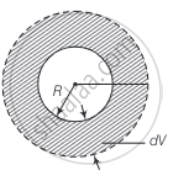Advertisements
Advertisements
प्रश्न
The radius of a metal sphere at room temperature T is R, and the coefficient of linear expansion of the metal is α. The sphere is heated a little by a temperature ∆T so that its new temperature is T + ∆T. The increase in the volume of the sphere is approximately ______.
पर्याय
2πRα∆T
πR2α∆T
4πR3α∆T/3
4πR3α∆T
उत्तर
The radius of a metal sphere at room temperature T is R, and the coefficient of linear expansion of the metal is α. The sphere is heated a little by a temperature ∆T so that its new temperature is T + ∆T. The increase in the volume of the sphere is approximately `underline(4πR^3α∆T)`.
Explanation:
Let the radius of the sphere is R. As the temperature increases the radius of the sphere increases as shown.

Original volume `V_0 = 4/3 piR^3`
Coefficient of linear expansion = α
∴ Coefficient of volume expansion = 3α
∴ `1/V (dV)/(dT)` = 3α
⇒ dV = 3Vαdt ≃ 4πR3α∆T
= Increase in the volume
APPEARS IN
संबंधित प्रश्न
A brass rod of length 50 cm and diameter 3.0 mm is joined to a steel rod of the same length and diameter. What is the change in length of the combined rod at 250 °C, if the original lengths are at 40.0 °C? Is there a ‘thermal stress’ developed at the junction? The ends of the rod are free to expand (Co-efficient of linear expansion of brass = 2.0 × 10–5 K–1, steel = 1.2 × 10–5 K–1).
If an automobile engine is overheated, it is cooled by pouring water on it. It is advised that the water should be poured slowly with the engine running. Explain the reason.
A system X is neither in thermal equilibrium with Y nor with Z. The systems Y and Z
A steel rod is clamped at its two ends and rests on a fixed horizontal base. The rod is unstrained at 20°C.
Find the longitudinal strain developed in the rod if the temperature rises to 50°C. Coefficient of linear expansion of steel = 1.2 × 10–5 °C–1.
Answer the following question.
State applications of thermal expansion.
A glass flask has a volume 1 × 10−4 m3. It is filled with a liquid at 30°C. If the temperature of the system is raised to 100°C, how much of the liquid will overflow? (Coefficient of volume expansion of glass is 1.2 × 10−5 (°C)−1 while that of the liquid is 75 × 10−5 (°C)−1).
A clock pendulum having coefficient of linear expansion. α = 9 × 10-7/°C-1 has a period of 0.5 s at 20°C. If the clock is used in a climate, where the temperature is 30°C, how much time does the clock lose in each oscillation? (g = constant)
A metre scale made of a metal reads accurately at 25 °C. Suppose in an experiment an accuracy of 0.12 mm in 1 m is required, the range of temperature in which the experiment can be performed with this metre scale is ______.(coefficient of linear expansion of the metal is `20 xx 10^-6 / (°"C")`
A metal rod of cross-sectional area 3 × 10-6 m2 is suspended vertically from one end has a length 0.4 m at 100°C. Now the rod is cooled upto 0°C, but prevented from contracting by attaching a mass 'm' at the lower end. The value of 'm' is ______.
(Y = 1011 N/m2, coefficient of linear expansion = 10-5/K, g = 10m/s2)
If the length of a cylinder on heating increases by 2%, the area of its base will increase by ______.
